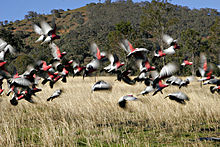- Cross-fostering
-
Cross-fostering is a technique used in animal husbandry, animal science, genetic and nature versus nurture studies, and conservation, whereby offspring are removed from their biological parents at birth and raised by surrogates. This can also occasionally occur in nature.
Contents
Animal husbandry
Cross-fostering young animals is usually done to equalize litter size. Individual animals born in large litters are faced with much more competition for resources, such as breast milk, food and space, than individuals born in smaller litters. Herd managers will typically move some individuals from a large litter to a smaller litter where they will be raised by a non-biological parent. This is typically done in pig farming because litters with up to 15 piglets are common. A sow with a large litter may have difficulty producing enough milk for all piglets, or the sow may not have enough functional teats to feed all piglets simultaneously. When this occurs, smaller or weaker piglets are at risk of starving to death. Herd managers will often transfer some piglets from a large litter to another lactating sow which either has a smaller litter or has had her own biological piglets recently weaned. Herd managers will typically try to equalize litters by number and also weight of individuals.[1] When done successfully, cross-fostering reduces piglet mortality.[2][3]
In research
Cross-fostering can be used to study the impact of postnatal environment on genetic-linked diseases as well as on behavioural pattern. In behavioral studies, if cross-fostered offspring show a behavioral trait similar to their biological parents and dissimilar from their foster parents, a behavior can be shown to have a genetic basis. Similarly if the offspring develops traits dissimilar to their biological parents and similar to their foster parents environmental factors are shown to be dominant. In many cases there is a blend of the two, which shows both genes and environment play a part.
In animal studies, genetically hypertensive offspring reared by normotensive dams shown to have lower blood pressure compared to the controls. This shown that hypertensive genotype could be modified by the changes of the postnatal environment. Besides this, hyperkinetic animals reared by a normal dam shown to have lower locomotion activity compared to its controls.
In selective livestock breeding this can be used to combine desirable genetic qualities such as weight, fat distribution or appearance with environmentally influenced ones such as temperament.
In humans, studies of children in foster care have shown that alcoholism is both genetic and environmental: early onset alcoholism can be linked to biological parentage, whereas adult onset alcoholism is often influenced by the alcohol abuse by foster parents.
In conservation
Cross fostering has been used in conservation biology such as the rearing of Black Robin chicks by other species. In this instance the species was so close to extinction, with literally a handful of surviving individuals and a single mother, there was little chance of raising many offspring. In this case a related species were used to raise the eggs, with their own eggs being replaced by conservation workers with those of the robin. In this case imprinting is one of the concerns, as species raised in a different environment may not be able to recognize their own species.
In nature
Cross fostering may occasionally occur in natural situations. In Australia, the closely related species from the cockatoo family, Eolophus roseicapilla (the galah) and Cacatua leadbeateri (the pink cockatoo), have overlapping ranges, and compete for nesting holes. However, two pairs of birds may share the same nest for a time, as they do not become aggressive until several eggs have been laid and incubation begins. When they do, the pink cockatoos are always the victors, evicting the galahs in what is termed interference competition. They are not consciously aware that some of the eggs in the nest were laid by the other bird however, and thus raise offspring of both species. These natural experiments have been used by Australian ornithologists Graeme Chapman and Ian Rowley to investigate the relative importance of genes and environment.[4] For example, they discovered that the galah chicks gave normal begging calls and alarm calls, but their contact calls (used to maintain social cohesion) were more like those of the pink cockatoos with which they lived.
Such natural instances of cross fostering can also lead to hybridization between species that would not normally breed. A case of this is offered by the Galapagos finches. Two species of the genus Geospiza, the Medium Ground-finch (Geospiza fortis) and the Common Cactus-finch (Geospiza scandens) occasionally hybridize. The birds' songs are a barrier to interbreeding, but sometimes young birds will not learn their own species song, e.g. if their father dies and they are nesting near another species. Another situation where birds can imprint on the wrong song is when one species takes over the nest of another, but fails to remove all of its eggs.[5] Cross fostered young can then hybridize with their foster parents' species, allowing gene flow between the two populations. Hybrids experience reduced fitness, however, so the two species can remain separate.
See also
- Brood parasite
- Captive rearing
- Phenotypic plasticity
- Supplementary feeding
- Twin studies
References
Notes
- ^ Cross Foster at Medical Dictionary
- ^ The Impact of Cross-Fostering on Swine Production
- ^ Dean and Bilkei (2004). Cross fostering of low-birthweight piglets. http://www.cababstractsplus.org/Abstracts/Abstract.aspx?AcNo=20043200780.
- ^ Rowley, I. & G. Chapman (1986) Cross-fostering, imprinting , and learning in two sympatric species of cockatoos. Behaviour 96: 1-16
- ^ Interview with Peter and Rosemary Grant, in Campbell, Neil; Jane B. Reece (2002). Biology. San Francisco: Benjamin Cummings. p. 1247 p. ISBN 0805366245.
Primary sources
- http://www.southalabama.edu/biology/faculty/obrien/teaching/bly122/Chapter%2047.pdf
- Alcock, J. (1998) Animal Behavior: An Evolutionary Approach (6th edition). Sinauer Associates, Inc. Sunderland, Massachusetts. ISBN 0-87893-009-4
Wikimedia Foundation. 2010.

